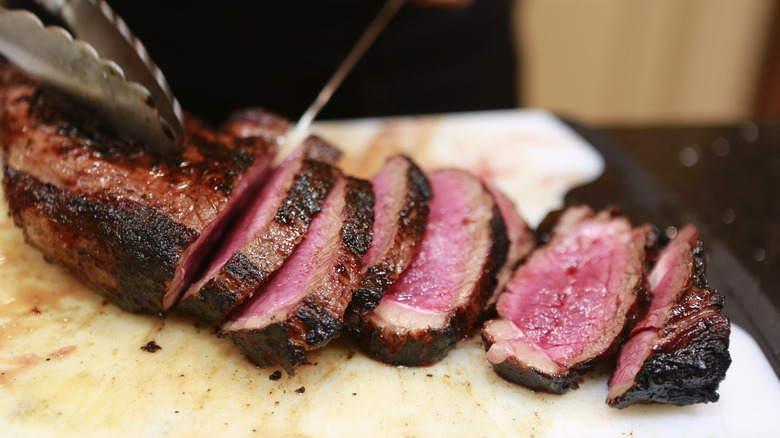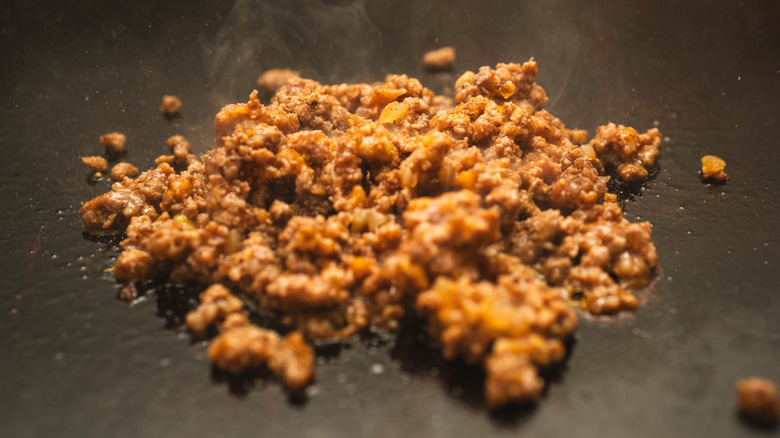Why Rare Steak Is Safe But Rare Ground Beef Is A Recipe For Disaster
We may receive a commission on purchases made from links.
You might have noticed that when it comes to cooking rare steak, pretty much everyone agrees that it's a great way to prepare and eat it. But when it comes to ground beef, like for a burger, it's the opposite — it must be cooked all the way through, the experts warn. What the heck? It's the same animal, the same meat: Beef. So what's the difference? As it happens, it has to do with how the beef is processed.
Bacteria exist everywhere, including on the surface of our foods. And with steak, there is just that — a clearly defined surface where the bacteria is more likely to be found; it can, therefore, be cooked off with a good sear on both sides or by removing the potentially contaminated surface (as with steak tartare). On the other hand, with ground beef, because the meat is essentially turned inside out as it's ground up, the exterior contaminated surface meets (pun intended) with the interior, and it all mixes up.
That means that any potentially harmful bacteria hanging out on the outer sides of the beef is now thoroughly incorporated throughout. Any machines or blades that touch the contaminated meat even once can further spread it around. The only way to kill that bacteria is to cook the ground beef thoroughly.
So what's the proper temperature for steaks and ground beef both to be considered safe?
An adequately cooked rare steak reaches about 120 degrees Fahrenheit; a good sear on a hot skillet should kill any bacteria lurking on the surface (though you might reserve your rare or medium-rare steaks for beef from a reputable source). It is recommended for optimum safety, however, that you cook your steaks to 145 degrees Fahrenheit or between medium and medium well. (And the steaks must rest for at least three minutes — which you should be doing anyway for perfection, according to Anthony Bourdain). Steak tartare, which is made from uncooked, totally raw beef mixed with other ingredients, is relatively safe, too, because typically, it's only made with the highest-quality meat, and the preparer has taken necessary steps to ensure consumer safety.
Ground beef, on the other hand, must be cooked to 160 degrees Fahrenheit in order to be considered safe to consume. This will ensure that the meat is cooked all the way through — no pinkness anywhere, no more living bacteria. And just to be sure that you are hitting the right temperature for both steaks and burgers, invest in a digital meat thermometer like this AMMZO Instant Read Digital Food Thermometer. Stick the probe into the thickest part of the meat, and be sure to wait for the temperature to stop climbing before reading it.
What are the dangers of eating undercooked beef?
Let's face it, though; even medium rare and rare steaks aren't 100% completely safe since they're only cooked to about 130 and 120 degrees Fahrenheit (respectively). And you might forgo the warning against consuming undercooked ground beef because you just love your medium-done all-American cheeseburgers too much. That's fine, and in most cases, you likely won't get sick, but it is a gamble. That's because certain bacteria, namely E. coli (which caused a 160 thousand-pound ground beef recall) and salmonella, tend to be found in cows.
These nasty microscopic creatures, if ingested, can turn your world — or rather, your stomach — upside down with food poisoning. Symptoms include gastrointestinal distress, like vomiting, cramping, and diarrhea, as well as fever, sweating, and fatigue. And while most people can shake off food poisoning after about a week, people with compromised immune systems, pregnant people, the elderly, and small children can have a tougher go of it — and it can even prove fatal. For this reason, if you and/or your family members fall into any of these groups, it might be best to avoid eating any undercooked beef just to be safe.



